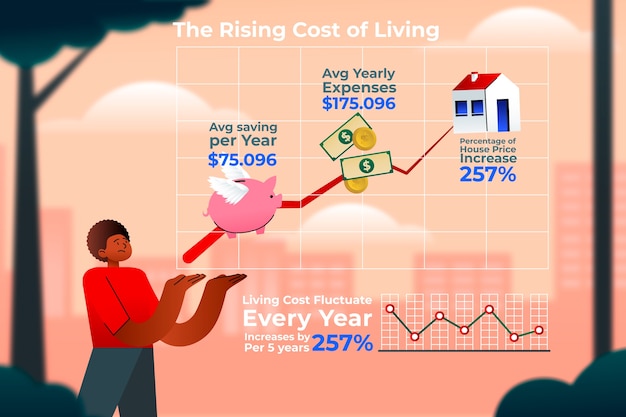Understanding the Federal Reserve’s Rate Hike & Mortgage Rates

Anúncios
Understanding the Federal Reserve’s Latest Interest Rate Hike and Its Effect on Mortgage Rates is crucial for homeowners and prospective buyers to navigate the complex financial landscape of the housing market.
Anúncios
The Federal Reserve’s decisions on interest rates ripple through the entire economy, and understanding how these changes impact mortgage rates is key for anyone involved in real estate. Let’s explore Understanding the Federal Reserve’s Latest Interest Rate Hike and Its Effect on Mortgage Rates.
What is the Federal Reserve and Why Does It Matter?
The Federal Reserve, often called the Fed, is the central bank of the United States. It plays a vital role in maintaining the stability of the financial system and managing the nation’s monetary policy. But what does that really mean for the average person, especially when it comes to mortgage rates?
Anúncios
The Fed’s decisions influence everything from inflation to employment, and understanding its function is essential for grasping the impact of interest rate hikes. Let’s delve into the Fed’s core responsibilities and how its actions shape the economic landscape.
The Fed’s Key Responsibilities
The Federal Reserve has several key responsibilities aimed at promoting a healthy economy. These include:
- Controlling inflation: The Fed aims to keep inflation at a stable level, typically around 2%, to ensure prices don’t rise too quickly.
- Maximizing employment: The Fed seeks to promote full employment by influencing interest rates and credit conditions.
- Stabilizing the financial system: The Fed works to prevent financial crises and ensure the stability of banks and other financial institutions.
- Regulating banks: The Fed oversees and regulates banks to ensure they operate safely and soundly.

Put simply, the Fed acts as a guardian of the economy, using its tools to steer the country towards steady growth and stability. One of the most powerful tools in its arsenal is the ability to adjust the federal funds rate, which directly affects borrowing costs across the board.
Understanding the Federal Funds Rate
The federal funds rate is the target rate that the Federal Reserve wants banks to charge one another for the overnight lending of reserves. While the Fed doesn’t directly set mortgage rates, changes to the federal funds rate have a significant impact on other interest rates, including those for mortgages.
When the Fed raises the federal funds rate, it becomes more expensive for banks to borrow money. This increased cost is often passed on to consumers in the form of higher interest rates for loans, including mortgages. Let’s explore how this mechanism works and its implications.
How the Federal Funds Rate Influences Mortgage Rates
Here’s a simplified breakdown of how the federal funds rate affects mortgage rates:
- The Fed raises the federal funds rate target.
- Banks increase their prime rate, which is the rate they charge their best customers.
- Mortgage rates, which are often tied to the prime rate or other benchmark rates, generally increase as well.
- Borrowing becomes more expensive, potentially cooling down the housing market.
Conversely, when the Fed lowers the federal funds rate, borrowing becomes cheaper, which can stimulate economic activity. Lower mortgage rates can make home buying more attractive, potentially boosting the housing market.
The connection between the federal funds rate and mortgage rates is not always direct or immediate. Other factors, such as inflation expectations, economic growth forecasts, and investor sentiment, can also play a role.
The Latest Interest Rate Hike: Context and Reasons
To truly understanding the Federal Reserve’s Latest Interest Rate Hike and Its Effect on Mortgage Rates, it’s important to consider the context of the decision. The Fed raises interest rates to combat inflation, especially when the economy is strong and prices are rising too quickly.
The decision to raise interest rates is often based on a variety of economic indicators, including inflation rates, unemployment figures, and overall economic growth. Let’s look at some of the factors that might have led to the latest rate hike.
Key Economic Indicators Influencing the Decision
Several factors might contribute to the Fed’s decision to raise interest rates:
- High inflation: If inflation is above the Fed’s target of 2%, it may raise rates to cool down the economy.
- Strong job growth: A robust job market can signal a healthy economy, potentially leading to inflationary pressures.
- Increased consumer spending: Higher spending can drive up demand and prices, contributing to inflation.
- Supply chain issues: Disruptions in the supply chain can lead to higher prices for goods and services.
By carefully monitoring these indicators, the Fed aims to strike a balance between controlling inflation and supporting economic growth. However, raising interest rates can have both positive and negative consequences for the economy and the housing market.
The Fed’s decisions are not made in a vacuum. It constantly analyzes economic data and consults with experts to make informed choices that align with its goals of price stability and full employment.
How the Rate Hike Affects Mortgage Rates
When the Federal Reserve hikes interest rates, the immediate effect is often felt in the mortgage market. Rising rates translate to higher borrowing costs for prospective homebuyers, influencing affordability and demand.
However, the impact on mortgage rates isn’t always a one-to-one correlation. Other factors like the 10-year Treasury yield, investor confidence, and the overall economic outlook also play significant roles. Let’s breakdown these influences.
The Direct and Indirect Impacts on Borrowers
The rising rate environment effects borrowers directly through:
- Increased Mortgage Rates: Higher rates mean larger monthly payments for new homebuyers.
- Reduced Affordability: A small rise in rates can decrease the amount a buyer can afford, potentially sidelining them from the market.
- Refinancing Disincentive: Existing homeowners are less likely to refinance, reducing the flow of money in the market.

The impact extends to the broader market, influencing housing prices, construction, and overall economic activity. A deep understanding the Federal Reserve’s Latest Interest Rate Hike and Its Effect on Mortgage Rates equips consumers and professionals with insight.
The effects are not uniform; they vary depending on factors like credit scores, income levels, and the type of mortgage being sought. Consumers who are well-informed are better positioned to navigate this changing landscape.
Navigating the Changing Mortgage Landscape
Dealing with rising mortgage rates requires potential homebuyers and current homeowners to make informed decisions. Understanding the available strategies and being adaptable becomes key to achieving financial goals.
This could include exploring different types of mortgages, considering adjustable-rate options, or making improvements to credit scores. Let’s discuss some approaches:
Strategies for Buyers and Homeowners
Some strategies for navigating rising rates include:
- Improve Credit Score: Better credit scores can unlock lower interest rates.
- Shop Around: Compare rates from multiple lenders to find the best terms.
- Consider an Adjustable-Rate Mortgage (ARM): ARMs may offer lower introductory rates.
- Increase Down Payment: A larger down payment can reduce the loan amount and potentially lower the rate.
Homeowners might consider making extra payments to reduce their principal faster or exploring options to refinance if rates decrease in the future. Adaptive tactics prove invaluable.
Seeking advice from financial professionals can provide personalized guidance tailored to individual circumstances. An informed approach can help buyers and homeowners alike to make confident choices.
Future Outlook and Predictions
Predicting the future direction of interest rates and their effect on mortgage rates is always challenging. Economic forecasts are subject to change, influenced by numerous factors both domestic and global.
However, by analyzing current trends and considering expert opinions, it’s possible to get a sense of what to expect in the coming months and years. Let’s review some potential scenarios and factors at play.
Possible Scenarios and Expert Insights
Some considerations when considering future rates include:
- Inflation Trends: Continues to be a primary driver of rate policy.
- Economic Growth: Determines the Fed’s overall posture.
- Global Events: Can shake domestic markets.
Experts emphasize the need for vigilance and adaptability in uncertain times. Staying informed about the latest economic developments and consulting with financial advisors can help individuals and families make sound decisions.
Ultimately, the future remains unpredictable, but preparation and informed decision-making can mitigate potential risks. Keep abreast of economic trends to stay ahead.
| Key Point | Brief Description |
|---|---|
| 🏦 Fed’s Role | Central bank impacting rates. |
| 📈 Rate Hikes | Increase borrowing costs. |
| 🏡 Mortgage Impact | Affects affordability, demand. |
| 💡 Strategies | Improve credit, shop around. |
Frequently Asked Questions
The federal funds rate is the target interest rate set by the Federal Reserve for banks to lend reserves to each other overnight. It influences other interest rates in the economy.
When the Fed raises rates, it becomes more expensive for banks to borrow money. This cost is often passed onto consumers in the form of higher mortgage rates.
Buyers can improve credit scores, shop for the best rates, consider ARMs, and increase their down payment to mitigate the impact of rising rates.
Generally, homeowners should not refinance if rates rise, as refinancing is typically done to secure a lower interest rate and reduce monthly payments.
Future rate hikes will depend on various factors including inflation trends, economic growth, and global events. Experts recommend vigilance and adaptability in uncertain times.
Conclusion
Understanding the Federal Reserve’s Latest Interest Rate Hike and Its Effect on Mortgage Rates requires constant vigilance, informed strategies, and professional guidance. By being equipped with knowledge, potential homebuyers and current homeowners alike can confidently navigate the complexities of the market. Staying in the know allows for educated decisions and financial stability.